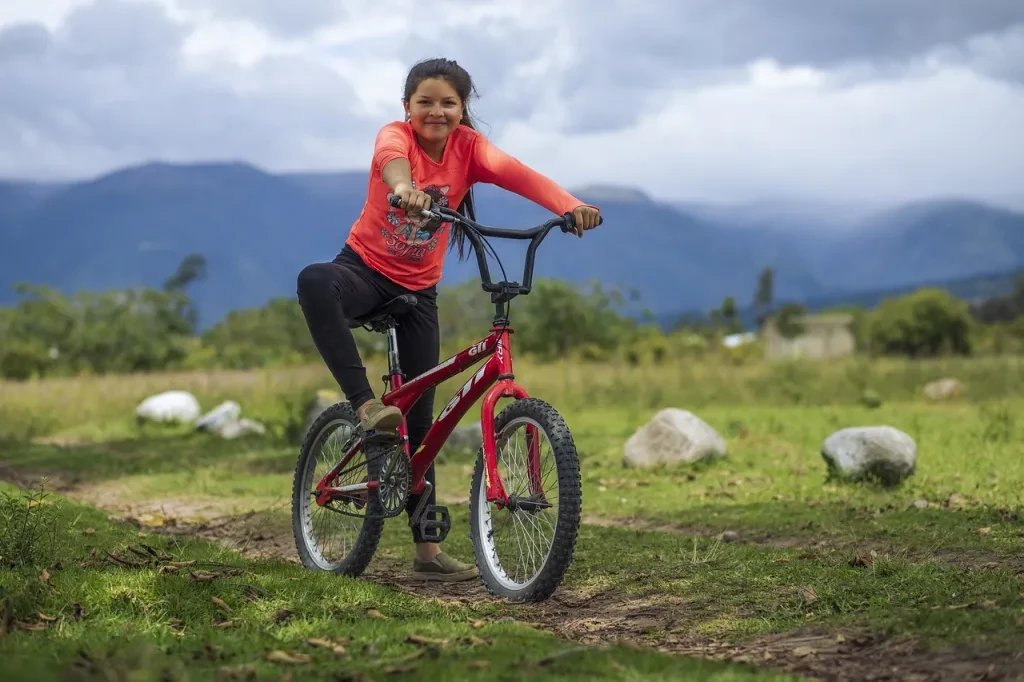Trail biking has surged in popularity over recent years, becoming a favorite outdoor activity for adventure enthusiasts and fitness buffs alike. This rise in interest has significantly impacted the trail bike market, leading to innovations and growth across various regions. In this article, we delve into the market overview, highlighting the growing popularity of trail biking, key market players, and regional trends and preferences.
Table of Contents:
Market Overview
Innovative Designs and Features
Technological Advancements in Trail Bikes
Comfort and Performance
Market Overview

Growing Popularity of Trail Biking
Trail biking has seen a remarkable increase in popularity, driven by a growing interest in outdoor activities and a heightened awareness of the health benefits associated with cycling. According to Statista, the global cycling wear market, which includes trail biking apparel, is projected to grow from USD 4.36 billion in 2023 to USD 6.54 billion by 2030, at a CAGR of 5.95%. This growth is indicative of the rising number of individuals taking up trail biking as a recreational activity.
The COVID-19 pandemic also played a significant role in boosting the popularity of trail biking. With lockdowns and social distancing measures in place, people sought outdoor activities that allowed them to maintain physical distance while staying active. Trail biking emerged as a perfect solution, offering both adventure and exercise in natural settings.
Key Market Players and Their Influence
The trail bike market is dominated by several key players who have significantly influenced the industry’s growth and direction. Companies such as Specialized Bicycle Components, Inc., SRAM LLC, and Shimano Inc. are at the forefront, driving innovation and setting trends. These companies invest heavily in research and development to introduce advanced features and technologies that enhance the trail biking experience.
Specialized Bicycle Components, Inc. is renowned for its high-performance trail bikes, which are designed to offer superior handling and durability. SRAM LLC, on the other hand, is a leader in bike components, providing cutting-edge gear systems and suspension technologies that improve ride quality. Shimano Inc. is another major player, known for its reliable and efficient bike components that cater to both amateur and professional cyclists.
The influence of these key players extends beyond product innovation. Their marketing strategies and sponsorship of trail biking events have played a crucial role in promoting the sport and attracting new enthusiasts. By sponsoring professional riders and events, these companies have helped elevate the profile of trail biking, making it more accessible and appealing to a broader audience.
Regional Trends and Preferences
The trail bike market exhibits distinct regional trends and preferences, influenced by factors such as geography, culture, and economic conditions. In North America, the United States and Canada are leading markets for trail bikes, driven by a strong outdoor culture and extensive trail networks. According to the U.S. Bureau of Labor Statistics, 96% of Americans engaged in sports and leisure activities in 2021, highlighting the region’s active lifestyle.
In Europe, countries like Germany, France, and the United Kingdom are prominent markets for trail bikes. The region’s well-developed cycling infrastructure and government initiatives promoting outdoor activities have contributed to the growth of the trail bike market. For instance, the European Union’s commitment to sustainable transportation and active lifestyles has led to increased investments in cycling infrastructure, further boosting the demand for trail bikes.
The Asia-Pacific region is also witnessing significant growth in the trail bike market, with countries like China, Japan, and Australia leading the way. The rapid expansion of eCommerce platforms in the region has made trail bikes more accessible to consumers, driving market growth. Additionally, the rising popularity of outdoor sports and adventure tourism in countries like India and Indonesia is expected to further fuel the demand for trail bikes.
Innovative Designs and Features

Advanced Suspension Systems
Trail bikes have seen significant advancements in suspension systems, which are crucial for handling rough terrains and providing a smooth ride. Modern trail bikes, such as the Santa Cruz Hightower S, feature sophisticated suspension setups that include both front and rear shocks. The Hightower S, for instance, boasts a 150mm front and 145mm rear suspension, making it a versatile choice for various terrains. This advanced suspension system allows riders to tackle rocky paths and steep descents with confidence, ensuring that the bike absorbs shocks effectively and maintains stability.
Another notable example is the Specialized Stumpjumper Evo, which is equipped with a 160mm front and 150mm rear suspension. This setup is designed to offer a plush ride while maintaining the bike’s agility and responsiveness. The suspension systems in these bikes are often adjustable, allowing riders to fine-tune their settings based on the trail conditions and their riding style.
Lightweight and Durable Materials
The use of lightweight and durable materials is another key innovation in trail bike design. Carbon fiber and aluminum are the most commonly used materials, offering a balance between weight and strength. The Santa Cruz Hightower S, for example, features a carbon frame that is both lightweight and robust, making it ideal for long rides and challenging trails.
Aluminum frames, like those found in the Salsa Timberjack XT 29, provide a cost-effective alternative without compromising on durability. This bike’s aluminum frame, combined with a 130mm front suspension, makes it a reliable choice for trail riding and bikepacking. The use of these materials not only enhances the bike’s performance but also contributes to its longevity, ensuring that riders can enjoy their investment for years to come.
Ergonomic and Customizable Components
Ergonomics and customization are crucial aspects of modern trail bike design. Bikes like the Specialized Stumpjumper Evo offer a range of frame sizes and adjustable components to accommodate different rider heights and preferences. This bike is available in six frame sizes, each with varying geometry to ensure a perfect fit for riders of all sizes.
Customizable components, such as adjustable seat posts and handlebars, allow riders to fine-tune their bikes for optimal comfort and performance. The ability to adjust these components ensures that riders can maintain a comfortable and efficient riding position, reducing fatigue and enhancing their overall experience on the trail.
Technological Advancements in Trail Bikes

Integration of Smart Technology
The integration of smart technology in trail bikes has revolutionized the riding experience. Modern trail bikes are equipped with features such as electronic shifting, GPS tracking, and performance monitoring. The Specialized Turbo Levo Comp Alloy, for instance, incorporates an electric motor that provides pedal assistance, making it easier for riders to tackle steep climbs and long distances.
This bike also features a smart display that provides real-time data on speed, distance, and battery life, allowing riders to monitor their performance and plan their rides more effectively. The integration of smart technology not only enhances the convenience and efficiency of trail riding but also opens up new possibilities for training and adventure.
Enhanced Safety Features
Safety is a top priority in trail bike design, and recent advancements have led to the development of enhanced safety features. Modern trail bikes are equipped with hydraulic disc brakes, which offer superior stopping power and control compared to traditional rim brakes. The Santa Cruz Hightower S, for example, features SRAM GX hydraulic disc brakes that provide reliable and consistent braking performance in all conditions.
Additionally, many trail bikes now come with integrated lighting systems and reflective elements to improve visibility during low-light conditions. These safety features ensure that riders can enjoy their adventures with confidence, knowing that their bike is equipped to handle any situation.
Eco-Friendly Manufacturing Processes
Sustainability is becoming increasingly important in the cycling industry, and many manufacturers are adopting eco-friendly practices in their production processes. Companies like Specialized and Santa Cruz are committed to reducing their environmental impact by using recycled materials and minimizing waste in their manufacturing processes.
For example, the Specialized Stumpjumper Evo is produced using a carbon frame that incorporates recycled fibers, reducing the bike’s overall carbon footprint. Additionally, these companies are investing in renewable energy sources and implementing sustainable practices throughout their supply chains. By prioritizing eco-friendly manufacturing processes, trail bike manufacturers are contributing to a more sustainable future for the sport.
Comfort and Performance

Optimized Frame Geometry
The geometry of a trail bike’s frame plays a crucial role in its comfort and performance. Modern trail bikes are designed with optimized frame geometry to provide a balanced and stable ride. The Santa Cruz Hightower S, for instance, features a slack head angle and a steep seat angle, which enhance its climbing efficiency and descending stability.
This optimized geometry ensures that riders can maintain a comfortable and efficient riding position, reducing fatigue and improving their overall performance on the trail. The Specialized Stumpjumper Evo also boasts a versatile geometry that can be adjusted to suit different riding styles and terrains, making it a popular choice among trail enthusiasts.
High-Performance Tires and Wheels
Tires and wheels are critical components that significantly impact a trail bike’s performance. Modern trail bikes are equipped with high-performance tires and wheels that offer excellent traction and durability. The Santa Cruz Hightower S, for example, comes with 29-inch tires that smoothly roll over rocks and roots, providing a stable and confident ride.
The Specialized Stumpjumper Evo features a mixed wheel setup, with a 29-inch front tire and a 27.5-inch rear tire. This “mullet” configuration combines the stability and rollover capability of a 29er with the agility and playfulness of a 27.5-inch wheel, offering the best of both worlds for trail riders.
Weather-Resistant Components
Trail riding often involves exposure to various weather conditions, and modern trail bikes are designed with weather-resistant components to ensure reliable performance in all environments. Bikes like the Salsa Timberjack XT 29 feature sealed bearings and corrosion-resistant materials that protect against moisture and dirt, extending the lifespan of the bike’s components.
Additionally, many trail bikes are equipped with weather-resistant drivetrains and suspension systems that maintain their performance even in wet and muddy conditions. These features ensure that riders can enjoy their adventures regardless of the weather, without worrying about damage or decreased performance.
Conclusion
The trail bike industry continues to evolve, with innovative designs and technological advancements enhancing the riding experience. From advanced suspension systems and lightweight materials to smart technology and eco-friendly manufacturing processes, modern trail bikes are designed to offer superior comfort, performance, and sustainability. As the industry moves forward, we can expect to see even more exciting developments that will further elevate the sport of trail riding, making it more accessible and enjoyable for riders of all levels.




